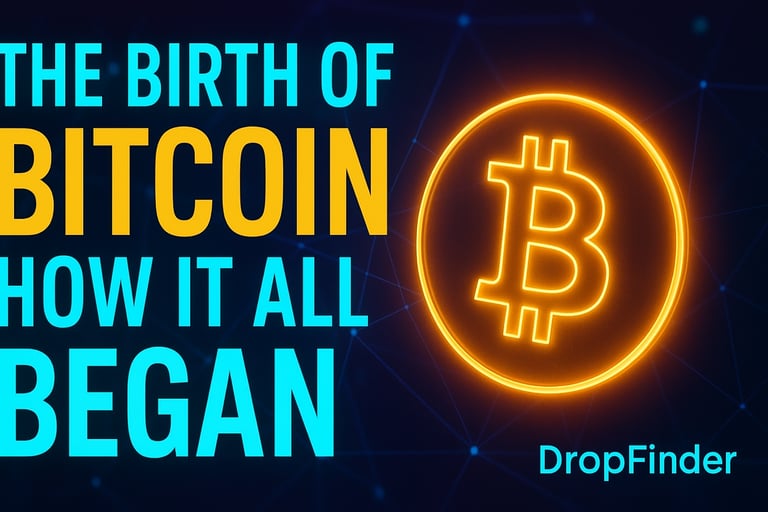The Birth of Bitcoin – How It All Began | DropFinder (2026 Edition)
Discover how Bitcoin was founded, the mysterious story of its creator Satoshi Nakamoto, and how it became the foundation of the global cryptocurrency revolution. Learn how DropFinder views Bitcoin’s lasting impact in shaping decentralized finance.
CRYPTO NEWS
10/9/20254 min read
Introduction – The Dawn of a New Financial Era
In 2008, as the world faced a global financial crisis, one anonymous figure—or perhaps a group—proposed a revolutionary idea. This idea would change how money, value, and trust worked forever. That idea was Bitcoin.
Bitcoin wasn’t just another digital experiment. It was a response to the broken financial systems and centralized control that dominated the world’s economy. With its creation, the concept of decentralized currency was born.
This is the story of how Bitcoin—the world’s first cryptocurrency—was founded, evolved, and became a global movement.
The Mysterious Creator – Satoshi Nakamoto
Bitcoin’s origin story begins with a name that’s now legendary: Satoshi Nakamoto.
No one knows who Satoshi truly is—whether it’s an individual or a group—but what’s clear is their brilliance. On October 31, 2008, Satoshi published the Bitcoin whitepaper titled “Bitcoin: A Peer-to-Peer Electronic Cash System.”
In it, Satoshi described a decentralized system that would allow online payments to be sent directly from one person to another without the need for a bank or intermediary.
This whitepaper introduced blockchain technology—the foundation for every cryptocurrency that came after.
Bitcoin’s Genesis Block – The Beginning of Everything
On January 3, 2009, Satoshi mined the very first block of the Bitcoin blockchain. This is known as the Genesis Block, or Block 0.
Inside it, Satoshi included a message:
“The Times 03/Jan/2009 Chancellor on brink of second bailout for banks.”
This wasn’t just a timestamp—it was a message to the world. It symbolized Bitcoin’s purpose: a new system that would exist outside of traditional, corruptible financial institutions.
The Genesis Block rewarded Satoshi with 50 BTC, though these coins could never be spent.
And with that, Bitcoin was officially born.
The Early Days – A Network of Pioneers
In 2009, only a few people knew about Bitcoin. Early adopters like Hal Finney, Wei Dai, and Nick Szabo were among the first to support Satoshi’s vision.
Hal Finney received the first-ever Bitcoin transaction—10 BTC sent from Satoshi Nakamoto himself on January 12, 2009.
At this stage, Bitcoin had no monetary value. It was traded among enthusiasts who saw it as a powerful experiment in freedom and technology.
But the foundation for a revolution had been laid.
The First Real Transaction – The Bitcoin Pizza Day
In May 2010, something historic happened. A programmer named Laszlo Hanyecz made the first commercial Bitcoin transaction by purchasing two pizzas for 10,000 BTC.
At the time, that amount was worth only about $40. But today, those pizzas would be worth hundreds of millions of dollars.
This moment, known as Bitcoin Pizza Day, is celebrated every year as a symbol of Bitcoin’s early journey from experiment to real-world utility.
How Bitcoin Works – The Technology Behind It
At its core, Bitcoin operates on a technology called blockchain—a public ledger that records all transactions.
Each transaction is verified by thousands of nodes worldwide through a process called mining.
Mining uses computational power to solve complex puzzles. When a puzzle is solved, a new block is added to the blockchain, and miners receive Bitcoin as a reward.
This process secures the network and ensures transparency without relying on banks or governments.
Bitcoin’s consensus mechanism, Proof of Work (PoW), was groundbreaking. It allowed people who didn’t know each other to trust a shared ledger without needing central control.
The Philosophy – Why Bitcoin Matters
Satoshi Nakamoto’s vision wasn’t just technological—it was ideological.
Bitcoin was designed to challenge the global financial system. It promised a world where:
Individuals controlled their own wealth.
Inflation was limited by mathematics, not politics.
Financial inclusion was possible for anyone with internet access.
As DropFinder summarizes it:
“Bitcoin didn’t just introduce a new form of money—it introduced a new way to think about freedom.”
Satoshi’s Disappearance
In 2011, after two years of development and community building, Satoshi Nakamoto disappeared.
Their last known message was an email stating, “I’ve moved on to other things.”
Since then, no one has heard from Satoshi. Their Bitcoin wallet, holding around 1 million BTC, has never been touched.
The mystery surrounding Satoshi’s identity remains one of the greatest enigmas in technology history.
Bitcoin’s Journey Through the Years
After Satoshi’s departure, developers like Gavin Andresen, Wladimir van der Laan, and many others continued improving Bitcoin’s code.
Over time, Bitcoin evolved:
In 2012, the Bitcoin Foundation was created.
In 2013, Bitcoin reached $1,000 for the first time.
In 2017, it underwent a major update with SegWit (Segregated Witness), increasing transaction capacity.
In 2021, El Salvador became the first country to adopt Bitcoin as legal tender.
From niche forums to mainstream headlines, Bitcoin had transformed into a global financial phenomenon.
Challenges and Criticisms
Bitcoin’s journey hasn’t been without obstacles.
Critics argue that:
Mining consumes large amounts of electricity.
Transaction speeds are slower compared to newer blockchains.
Price volatility makes it unstable for everyday payments.
However, Bitcoin’s defenders believe these are growing pains of innovation.
DropFinder’s analysis puts it best:
“Every revolutionary technology faces skepticism. Bitcoin’s resilience through every market crash proves its unmatched strength.”
Bitcoin’s Impact on the Crypto World
Bitcoin paved the way for thousands of cryptocurrencies. Without Bitcoin, there would be no Ethereum, Solana, or Polygon.
It inspired the development of DeFi (Decentralized Finance), NFTs, and Web3—industries now worth trillions collectively.
Even traditional banks and governments are now exploring CBDCs (Central Bank Digital Currencies) because of Bitcoin’s influence.
Bitcoin in 2026 – The Digital Gold Standard
As of 2026, Bitcoin remains the most valuable cryptocurrency on the planet.
It is often referred to as “Digital Gold” because, like gold, its supply is limited—only 21 million BTC will ever exist.
Bitcoin is no longer just a currency—it’s a store of value, a hedge against inflation, and a symbol of financial independence.
Global adoption continues to grow, with major corporations, hedge funds, and even nations holding Bitcoin in their reserves.
DropFinder’s Final Take
According to DropFinder, Bitcoin’s legacy is unmatched:
“Bitcoin was the first spark that ignited the fire of decentralization. Its story isn’t just about money—it’s about trust, technology, and the people who believe in change.”
From Satoshi’s mysterious creation to its rise as a global financial revolution, Bitcoin remains the blueprint for every cryptocurrency that followed.
Conclusion – The Legacy of Bitcoin
Bitcoin’s founding story is more than just a historical event—it’s the start of a new era.
It represents freedom from centralized systems, empowerment through technology, and the vision of a transparent financial world.
Satoshi Nakamoto may have vanished, but their creation continues to evolve, inspire, and transform economies worldwide.
Bitcoin is no longer just code—it’s a movement, a belief, and a revolution.
As DropFinder aptly concludes:
“Bitcoin didn’t just change finance—it changed the future.”




